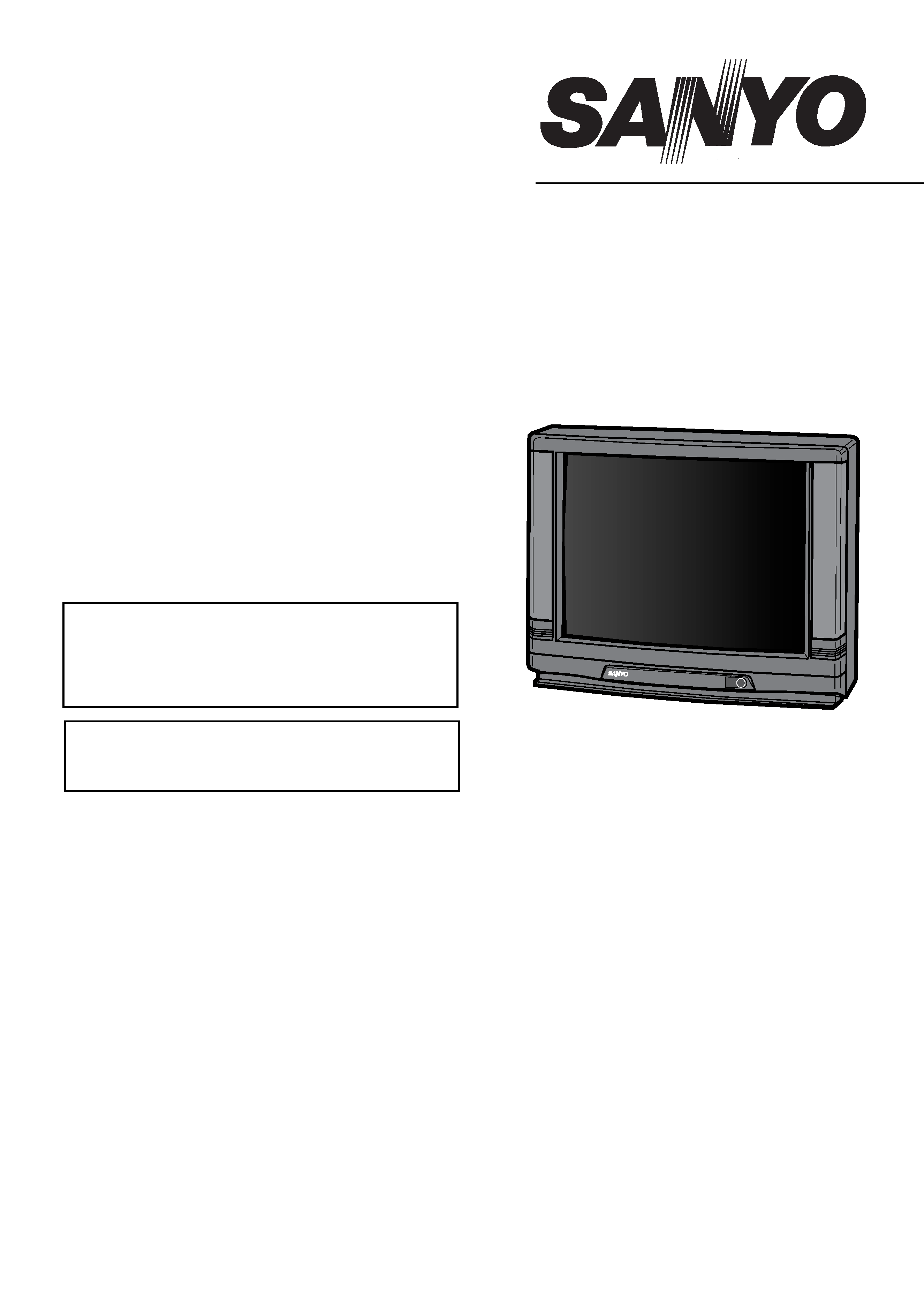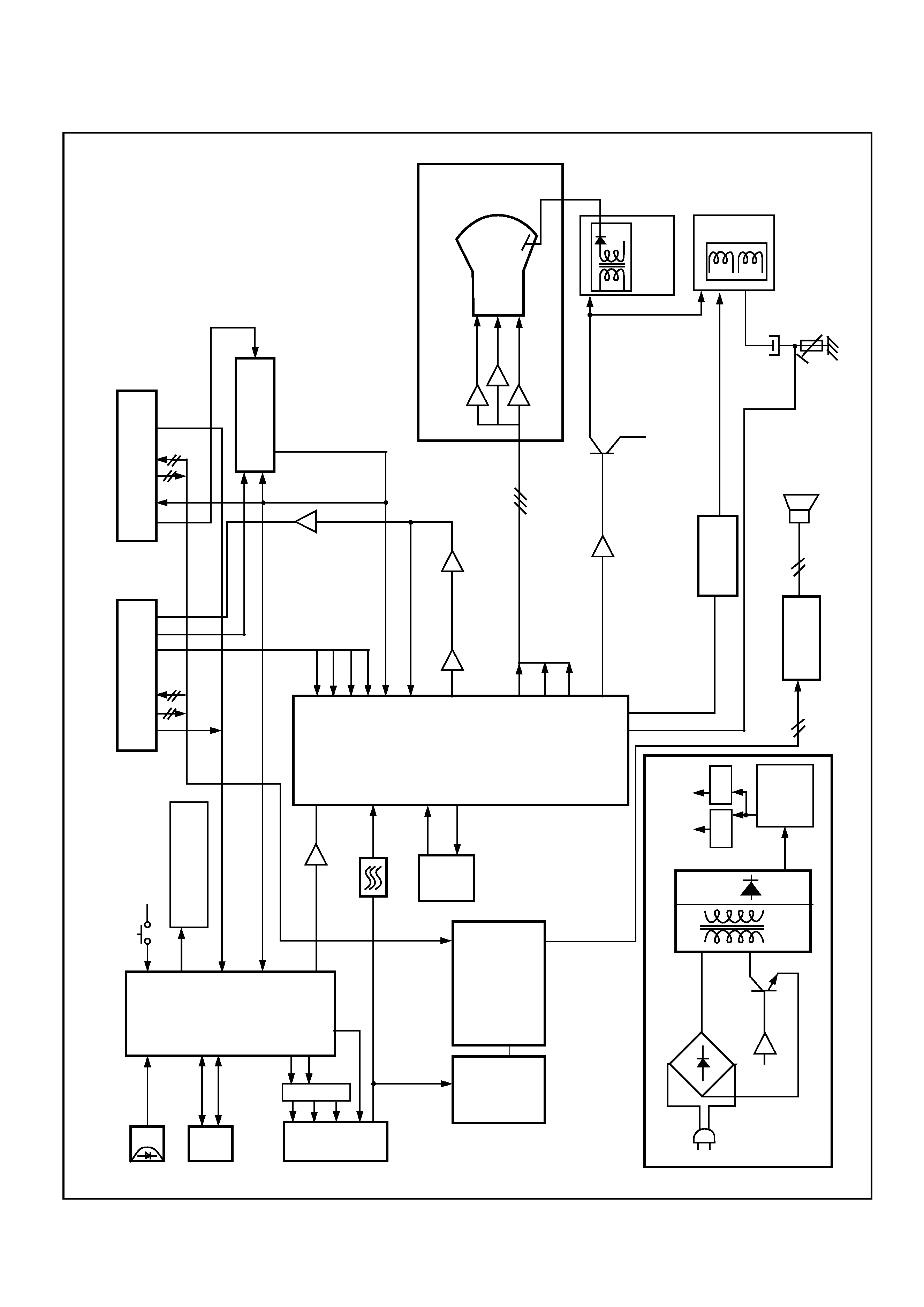
Part No.
SKSM0268
F2WDMK
SEPT 98
Colour Television
Service Manual
CE28P1-C (W.Europe)
Service Ref. No.
CE28P1-C-00
PRODUCT CODE: 111325303
ORIGINAL VERSION: Chassis No. EB4-A
Give complete "SERVICE REF. NO." for parts order or
servicing, it is shown on the rating sheet on the
cabinet back of the TV set.
Note
This TV receiver will not work properly in foreign
countries where the television transmission system
and power source differ from the design specifications.
Refer to the specifications for the design specifications
Specifications
Power source
AC 220~240V 50Hz
Television system
System B/G
Colour system
PAL
Receiving channel
VHF: E2-E12
CATV: X, Y, Z, S1-S41
UHF: #21~69
Aerial input impedance
75ohm
AV terminal
21 Pin socket
CENELEC standard
Sound output(Music)
12 watts X2
Picture tube
70cm diagonal, 110 degree
(Visible picture diagonal)
66cm
Dimensions (WxHxD)
740 x 585 x 494mm
Weight
31.5 Kg
CE28P1-C

-2-
F2WDMK
SAFETY PRECAUTION
X-RADIATION PRECAUTION
The primary source of X-RADIATION in the television receiver is the picture tube. The picture tube is specially
constructed to limit X-RADIATION emissions. For continued X-RADIATION protection, the replacement tube must
be the same type as the original including suffix letter. Excessive high voltage may produce potentially hazardous
X-RADIATION. To avoid such hazards, the high voltage must be maintained within specified limit. Refer to this
service manual, high voltage adjustment for specific high voltage limit. If high voltage exceeds specified limits,
take necessary corrective action. Carefully follow the instructions for +B1 volt power supply adjustment, and high
voltage adjustment to maintain the high voltage within the specified limits.
PRODUCT SAFETY NOTICE
Product safety should be considered when a component replacement is made in any area of a receiver.
Components indicated by mark //!\ in the parts list and the schematic diagram designate components in which
safety can be of special significance. It is particularly recommended that only parts designated on the parts list in
this manual be used for component replacement designated by mark /!\ . No deviations from resistance wattage
or voltage ratings may be made for replacement items designated by mark /!\ .
1: An isolation transformer should be connected in the
power line between the receiver and the AC line when
a service is performed on the primary of the converter
transformer of the set.
2: Comply with all caution and safety-related notes
provided on the cabinet back, inside the cabinet, on
the chassis or the picture tube.
3: When replacing a chassis in the cabinet, always be
certain that all the protective devices are installed
properly, such as, control knobs, adjustment covers or
shields, barriers, isolation resistor-capacitor networks
etc.Before returning any television to the customer,
the service technician must be sure that it is
completely safe to operate without danger of electrical
shock.

-3-
F2WDMK
BLOCK DIAGRAM
This is a diagram for all models and therefore differs slightly from the actual block diagram.
IC801
CPU
21P
Scart:
AV1
21P
Scart:
AV2
IC201
IF/Video/Chroma/Def.
IC1202
CVBS
int/ext
sw.
CRT
Unit
FBT
DY
IC001
Audio
Output
IC501
Vert.
Output
T611
Converter
Transformer
Power
Supply
Circuit
SIF
Unit
Audio
Unit
Tuner
IC802
Memory
47
49
50
SCL
SDA
RC
Pre.amp
6
5
51
52
IC810
Band
sw.
14
24
17
18
2
3
4
5
2:
Bright
3:
Contranst
4:
Colour
5:
Sharpness
Control
Keys
10
VL
VH
U
IF
TU
1
16
45/46
28/29
30/31
41
48
37
18
19
20
7
13
15
21
22
23
24
X131
SAW
Filter
IC271
1H
Delay
R-Y/B-Y
R-Y/B-Y
CVBS
In
Functuin
In(AV1/AV2)
11/12
14/16
B
G
R
BLK
External
CVBS
in
Internal
CVBS
in
Q151
Q152/Q154
H-Drive
Q431
Q432
H-Outpit
V-Drive
V-Feedback
Audio
In
Speakers
VR501
C512
H
V
HV
Q2601
Q2611
Q2621
Q171
1
6
3
8
Out
Audio
I/O
Audio
I/O
Video
I/O
Video
I/O
RGB/BLKIn
B1:
150V
B2:
25V
B3:
15V
B4:
24V
IC651
IC652
B6:
12V
B8:
5V
B7:
8V
L,
R
L,
R
1/
5
10/
8
AC
In
Q612
Q613
V-In
V-In
R
G
B
CVBS
In
AudioI/O
SIFIn
Audio
Out
L,
R
4
2

-4-
F2WDMK
1. POWER SUPPLY
The power supply circuit of the EB4-A chassis is
composed of a rectifier smoothing circuit, an oscillation
circuit, a control circuit and an output rectifier circuit. The
AC input voltage is full-wave rectified by the rectifier
smoothing circuit, and an unstable DC voltage is
generated at both terminals of the smoothing capacitor
C607. This voltage is input to the oscillation circuit. The
oscillation circuit is provided with a blocking oscillator
circuit that switches the switching transistor Q613 ON
and OFF, and an oscillation frequency and a duty square
wave pulse are generated in the input windings
according to operation of the control circuit. A square-
wave pulse whose size is dependent on the turn ratio of
the input and output windings is obtained in the output
winding. This is rectified in the output rectifier circuit, and
the desired DC voltage is obtained.
2. IF & DEFLECTION (TDA8361)
The IF output signal from the tuner passes through the
SAW filter, and it is input to pin45 and pin46 of IC201.
The signal input to the IC passes through the IF
amplifier, video detection and video amplifier circuits and
is output from pin7 as a composite video signal. And
after this signal is converted to impedance at Q151,
supplies to the video and chroma amplifier stages.
The sync.-separation circuit separates the video signals
applied to pin13(internal video signal) or pin15(external
video signal) to vertical- and horizontal-sync. signals
respectively. The horizontal oscillator requires no
external components and is fully integrated. The
oscillator is always running when the start-pin36 is
supplied with 8V. Horizontal drive signal is output from
pin37. VR361 is for adjustment of the horizontal centring.
The separated vertical-sync. signal from sync. separation
circuit passes through the vertical-separation circuit, and
applied to trigger divider circuit. The horizontal oscillation
pulse and input vertical sync. pulse are monitored by the
trigger divider circuit, and switching 50Hz and 60Hz
system, the vertical amplitude automatically adjusted for
50Hz and 60Hz. The output signal from the trigger
divider is triggered vertical oscillation circuit consisting of
C351, R352 and pin42, and vertical drive pulse is output
from pin43. VR501 is for changing the amount of AC
feedback applied to pin41 and for adjustment of the
vertical amplitude.
3. VIDEO CHROMA & R.G.B. (TDA8361)
The composite video signal output from the pin7 of
IC101 passes through Q151-Q154, and it is supplied to
pin13. The external video signal output from SCART is
supplied to pin15. The video signal input to pin13 or
pin15 is separated to luminance (Y) signal and chroma
signal in IC201. These pins are used in common with
H/V-sync. separation input. The peaking of Y signal is
adjusted by DC voltage of pin14. ("SHARPNESS"
control) The chroma signal is divided into R-Y and B-Y
chroma signals, demodulated in IC201, and output from
pin30 (R-Y) and pin31 (B-Y). These chroma signals pass
through the 1H delay line circuit (IC271), and they are
input to pin29 (R-Y) and pin28 (B-Y). These R-Y/B-Y
signals pass through RGB matrix circuit and RGB
selector circuit of IC101. The internal RGB signals are
generated in RGB matrix circuit and the RGB selector,
consisting linear amplifiers, clamps and selects either the
internal RGB signals or the external RGB signals input
from pin22(R), pin23(G), pin24(B). Selection is controlled
by the voltage at the RGB switch control (pin21) and
mixed RGB modes are possible since RGB switching is
fast. The RGB switch also functions as a fast blanking
pin by blanking the RGB output stages; here internal and
external RGB signals are overruled. The colour gain is
controlled by DC voltage of pin26. ("COLOUR" control)
The contrast control voltage present at pin25, and the
brightness control voltage present at pin17 controls DC
level of RGB signals. The RGB signals are finally
buffered before being available at the RGB output pins
[pin20 (R), pin19 (G), pin18 (R)].
4. AUDIO OUTPUT(TDA7263M)
The audio signals output from the audio unit are input to
pin1(L) and 5(R) of IC171 and passes through the pre-
amplifier circuit and drive circuit, after which it is input to
the audio amplifier. The audio amplifier is an SEPP
(single-ended, push-pull) OTL type and output to pin8(R)
and 10(L) to directly drive the speakers.
5. VERTICAL OUTPUT (LA7832/LA7832)
An IC (LA7832/LA7833) is used for the vertical output
circuit in this chassis. The vertical drive pulse from pin43
of IC201 is input to pin4 of IC501. This pulse drives
IC501, and vertical scanning is performed. In the first half
of scanning a deflecting current is output from pin2 and
passes through the following path:
Vcc(B4) © D501 © pin3 © pin2 © DY © C512 ©
VR501/R509. An electric charge is then stored in C512.
In the last half of scanning the current path is C512 ©
DY © pin2 © pin1 © VR501/R509 © C512. In this way,
an amplifying sawtooth waveform current flows directly to
DY to perform electron beam defection. Next, in the first
half of the banking period the vertical drive pulse
suddenly becomes OFF, and in order to reduce the
current flowing to DY, the current path becomes as
follows by the inductance of DY:
DY © pin2 © pin1 © VR501/R509 © C512 © DY. Also,
when the charge of DY has dissipated, the current path
becomes Vcc24V © pin6 © pin7 © C502 © pin3 ©
pin2© DY © C512 © VR501/R509, and when the
prescribed current value is reached, the vertical drive
pulse becomes ON. This completes one cycle.
CIRCUIT DESCRIPTION

-5-
F2WDMK
6. HORIZONTAL OUTPUT
A horizontal oscillation signal is output from pin37 of
IC201 and switches the drive transistor Q431. This
switching signal is current amplified by the drive
transformer T431 and drives the output transistor Q432.
When Q432 becomes ON, an amplifying current flows
directly to DY through C441 © DY © 0432 © GND, and
defection is performed in the last half of the scanning
period. Next, when Q432 becomes OFF, the charge that
had been stored in DY up to that point releases a
resonance current to the resonant capacitors C421/C423
and charges them. The current stored in C421/C423 is
then flowed back to DY, and an opposite charge is then
stored in DY. This opposite charge then switches the
dumper diode in Q432 ON, the resonance state is
completed, and an amplifying current is then flowed
again directly to DY through the dumper diode. By this
means, deflection in the first half of the scanning period
is performed, and when Q432 becomes ON at the end of
the first half of the scanning period, deflection during the
last half is begun, thus completing one cycle.
In the PCC circuit consisting of Q461 and Q462, the
parabola signal supplied from the vertical circuit is added
at the horizontal output stage and pincushion
compensation is performed by varying the DC voltage
bias. Further, the ABL voltage is feedback to the base of
Q462 to compensate for width variations due to
variations in the beam current.
7. CPU <System and Teletext Control>
Pin description
Pin1: Tuning voltage output
Pin2: Brightness control output (6-bit DAC)
Pin3: Contrast control output (6-bit DAC)
Pin4: Colour control output (6-bit DAC)
Pin5: Sharpness control output(6-bit DAC)
Pin6: Not used (GND)
Pin7: Not used (GND)
Pin8: Power ON/OFF output (H:ON)
Pin9: AFT signal input
Pin10: Option SW1 & Keyboard scan input (DC)
Pin11: Option SW2
Pin12: 50/60Hz switch input (50Hz: Hi)
Pin13: GND
Pin14: TV/AV switch output (TV: Hi)
Pin15: S-VHS switch output (S-VHS: Hi)
Pin16: Option SW3 (2AV: Hi)
Pin17: Function signal input for SCART1
Pin18: Function signal input for SCART2
Pin19: Power LED drive output1
Pin20: Option SW4 & Power LED drive output2
Pin21: Ignore output
Pin22: GND
Pin23: CVBS input0 (Internal)
Pin24: CVBS input1 (Internal/External)
Pin25: Black
Pin26: IREF
Pin27: Odd/Even output
Pin28: GND
Pin29: -
Pin30: V-deflection stop output
Pin31: RGB REF
Pin32: Blue output for OSD
Pin33: Green output for OSD
Pin34: Red output for OSD
Pin35: Blanking output for OSD
Pin36: H-sync. input (Horizontal pulse for OSD)
Pin37: V-sync. input (Vertical pulse for OSD)
Pin38~39: Supply (+5V)
Pin 40: OSC GND
Pin 41: Oscillator input for CPU
Pin 42: Oscillator output for CPU
Pin 43: Reset input
Pin 44: Supply (+5V)
Pin 45: Protect signal input (L:Power circuit defects)
Pin 46: Ident. signal input
Pin 47: R/C signal input
Pin 48: Mute output in no picture
Pin 49: I2C bus SCL (Serial clock)
Pin 50: I2C bus SDA (Serial date)
Pin 51: Option SW5 & Band select output1
Pin 52: Band select output2
